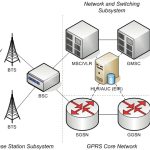Listed below are the features of GSM that account for its popularity and wide acceptance.
· Improved spectrum efficiency
· International roaming
· Low-cost mobile sets and base stations (BSs)
· High-quality speech
· Compatibility with Integrated Services Digital Network (ISDN) and other telephone company services
· Support for new services
GSM History
The following table shows some of the important events in the rollout of the GSM system.



A GSM network comprises of many functional units. These functions and interfaces are explained in this chapter. The GSM network can be broadly divided into:
• The Mobile Station (MS)
• The Base Station Subsystem (BSS)
• The Network Switching Subsystem (NSS)
• The Operation Support Subsystem (OSS)
Given below is a simple pictorial view of the GSM architecture.

The additional components of the GSM architecture comprise of databases and messaging systems functions:
· Home Location Register (HLR)
· Visitor Location Register (VLR)
· Equipment Identity Register (EIR)
· Authentication Center (AuC)
· SMS Serving Center (SMS SC)
· Gateway MSC (GMSC)
· Chargeback Center (CBC)
· Transcoder and Adaptation Unit (TRAU)
The following diagram shows the GSM network along with the added elements:

The MS and the BSS communicate across the Um interface. It is also known as the air interface or the radio link. The BSS communicates with the Network Service Switching (NSS) center across the A interface.


